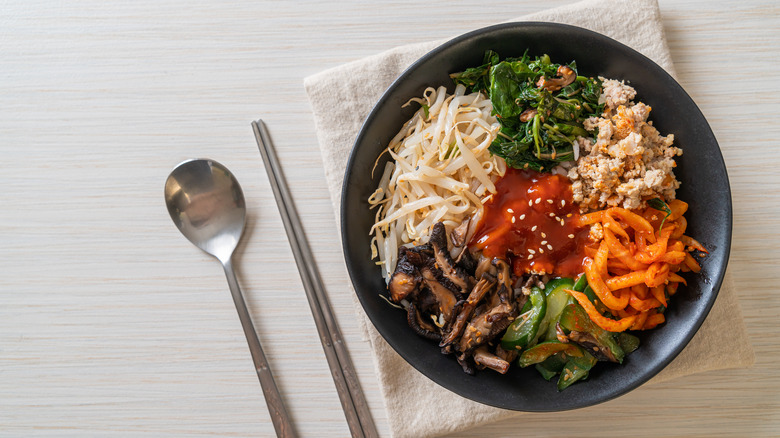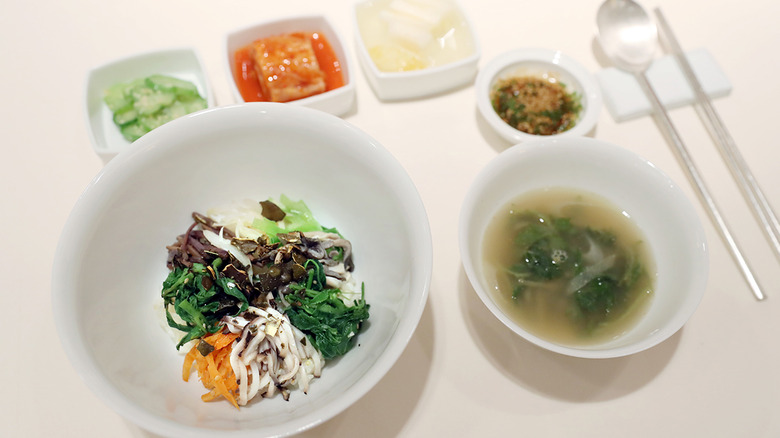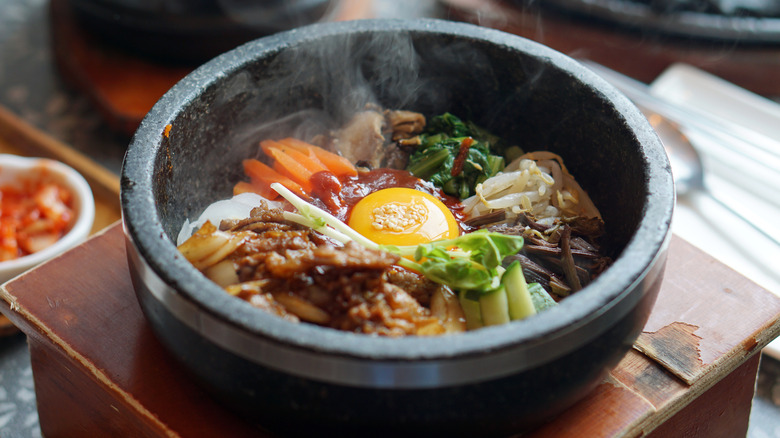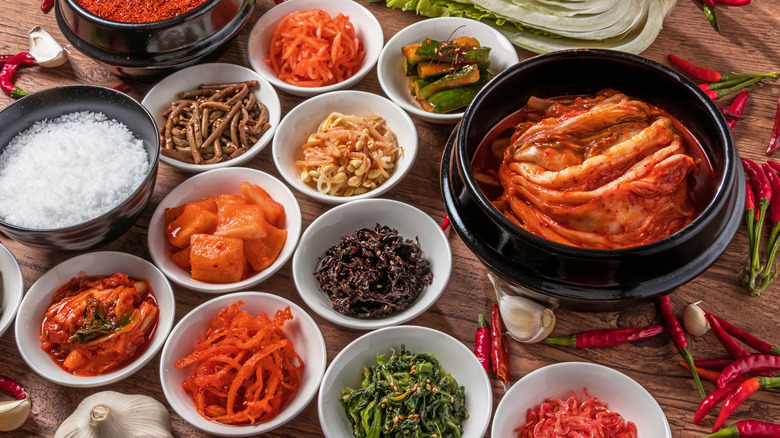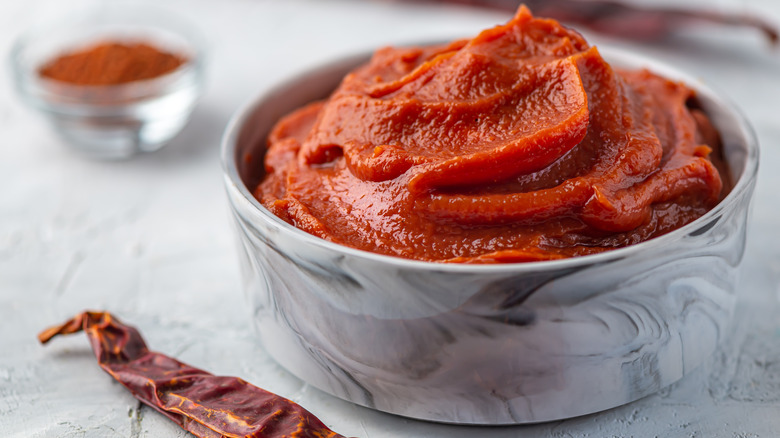Everything You Need To Know About Bibimbap
If you haven't yet had an opportunity to try bibimbap, or have been avoiding the dish altogether because you weren't sure exactly what you would be eating, there are so many reasons to give this popular Korean dish a chance.
According to Go! Go! Hanguk, bibimbap is a straightforward dish and translates loosely to mixed (bibim) rice (bap). It's essentially a bowl with a base of grains that's then topped with an assortment of vegetables and meat before the traditional sweet and spicy sauce (made with gochujang) is poured on top. Some varieties of bibimbap, like Jeonju bibimbap (named for the popular Korean tourist city), have up to thirty different ingredients added, including mung bean paste, raw egg yolks, dates, nuts, and various vegetables, according to Korea Tour Information.
As they note, Jeonju bibimbap is thought to have originated from the Korean royal table, where it was considered a luxury dish for the wealthy court members. The city of Jeonju even celebrates the dish with an annual bibimbap festival (per their website), where each of the city's 35 districts prepares its own unique style for visitors to try.
Make bibimbap your own dish with easy customization
One of the best features of bibimbap is that there's no one right way to enjoy it. Whether you're vegetarian, vegan, or a meat-lover, you can customize your dish pretty much however you choose. Starting with a rice base, simply add whatever veggies you'd like (these can be raw, pickled, or cooked, depending on preference). Some of the traditional vegetable toppings according to How To Feed A Loon include bean sprouts, carrots, kimchi, spinach, mushrooms, and zucchini, though you can add whatever produce you have on hand.
Then add any meat you may want — or skip it altogether. If you want a meat-based dish, a popular modern take is using bulgogi beef as a topping — bulgogi is sweet and spicy steak strips made with soy sauce, sesame oil, and brown sugar, per Edible Communities. Many recipes also serve bibimbap with a fried sunny-side egg on top. No matter what you choose, the dish always turns out gorgeous with the variety of colors and textures, which gives the eater even more reason to enjoy it.
Cookware is important for different types of bibimbap
Some popular methods for serving this traditional Korean dish include using a stone pot called a dolsot, according to Kimchi Mari, or in a brass bowl known as yangpun (per My Korean Kitchen). A dolsot is usually made of granite, says The Kitchn, and is used to cook several different Korean dishes. In the case of bibimbap, the pre-cooked ingredients are placed in a steaming hot dolsot where they continue to cook, giving you that deliciously crispy burnt rice at the bottom of the bowl. On the other hand, yangpun bibimbap is traditionally meant for sharing with others, says My Korean Kitchen.
Before diving in, mix everything together and blend it nicely (especially if you have a fried egg on top) to evenly distribute both the sauce and the toppings throughout the rice. If you're making or ordering dolsot bibimbap, though, let it sit for a few minutes before mixing to allow the rice to get nice and crispy. However you choose to enjoy this incredible and versatile dish, it's guaranteed to be delicious!
Bibimbap is often made with leftovers
One hypothesis for the origin of bibimbap (via Creatrip) is that it was created as a way for Koreans to use up their leftovers. Unlike Westerners, Korean dinner tables often feature many different side dishes, and plating them on a bed of rice is a great way to make a new meal out of old food, ensuring it doesn't go to waste.
While there isn't hard evidence that this is the true origin of bibimbap, this is still a practice used by many Koreans today, along with other global lovers of this versatile rice dish, according to the Washington Post. So, if you have any veggies that are on the cusp of going bad but could still hold up with being sautéed, or leftover proteins like tofu, chicken, or steak to use, this is your dish. Even if you have just a few small items (say a few carrots or cucumbers, plus an egg), it's easy enough to transform them from something unexciting into this delicious dish with some rice, sesame oil, and chili bean paste. Now's your chance to get creative in the kitchen!
Bibimbap sauce needs one key ingredient
Before you set yourself up to make a steaming bowl of bibimbap, make sure you have a few necessary ingredients to create the famed sauce that ties it altogether. (Just like you wouldn't set out to make biscuits and gravy without having the ingredients for the gravy!) Thankfully, it's both easy and cheap to produce, and you probably have most of the ingredients for the sauce on hand already with the exception of one: gochujang.
This thick red chili paste is a staple in Korean cooking. It's made of red chilis, glutinous rice, salt, and fermented soybeans. It gives many Korean dishes, including bibimbap, depth of flavor and has a little kick that you'd be hard-pressed to find without it. Gochujang can be found in the international aisle of many grocery stores. Even better, it has a long shelf life when stored in the fridge, so you can use it for plenty of bibimbap nights in the future. After acquiring gochujang, all you need to make the sauce is sesame oil, sugar, vinegar, garlic, and water (per My Korean Kitchen) — and boom, you've got yourself a memorable dinner.
